Your cart is currently empty!
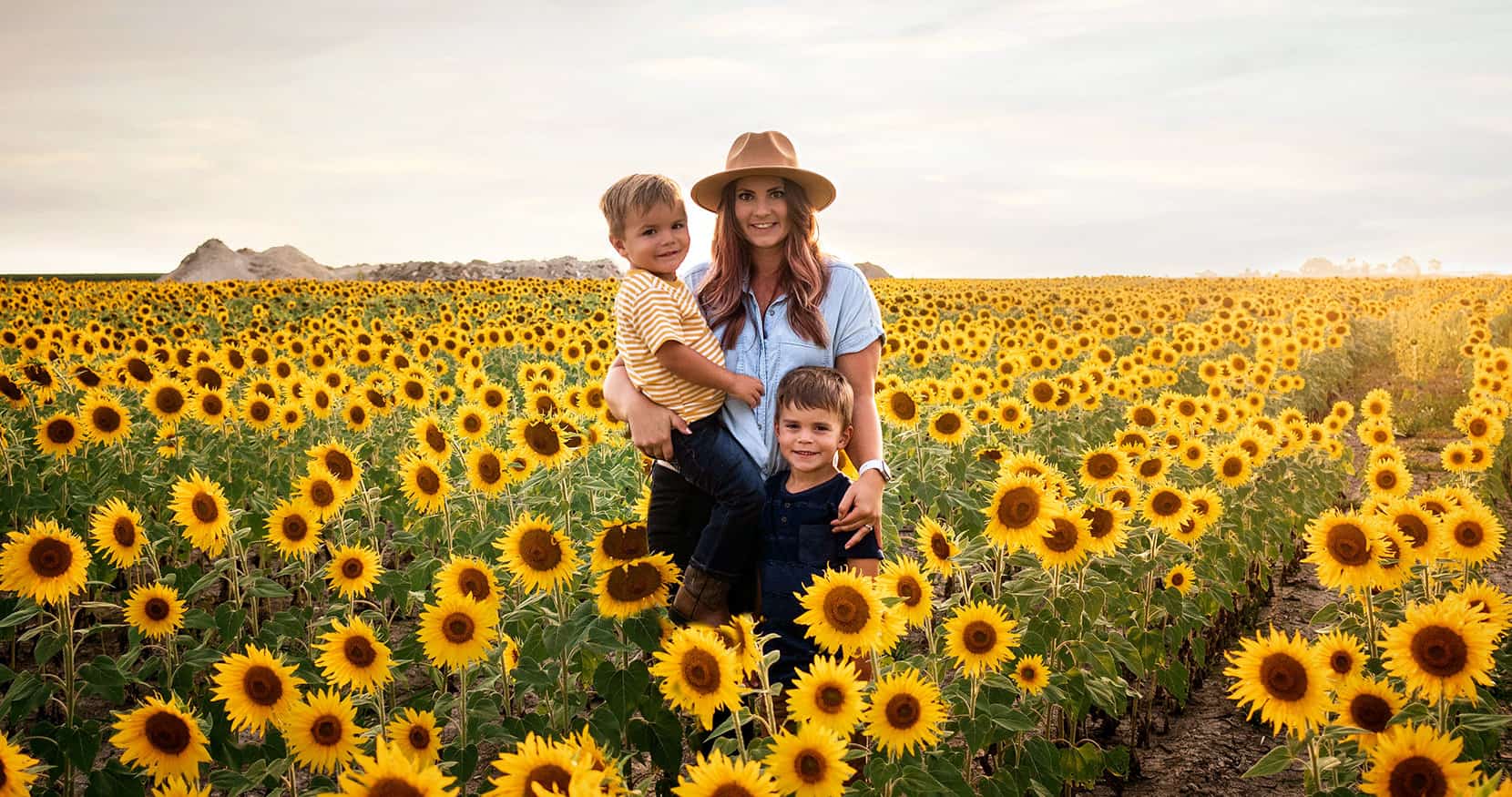
How to Take Photos at a Sunflower Field with Your Family
Summer’s warm weather and lax schedule beckon us busy parents to slow down, embrace the season’s vibrant spirit, and create moments that transcend the mundane. Our quest for treasured family experiences becomes an art in itself. Amidst this pursuit, there lies a hidden gem – a canvas of golden blooms that offers a breathtaking escape from the everyday chaos. Sunflower fields! Those radiant symphonies of nature, hold the promise of something truly extraordinary. Today, writer, editor, and Kansas City mom Sarah Boles delves into the unique experience of visiting sunflower fields during the summer and capturing family photos that are as exceptional as they are heartwarming. So, fellow momtogs, step out of your routine, and let’s explore the world of sunflowers and the magic they can infuse into your family’s photographic story.
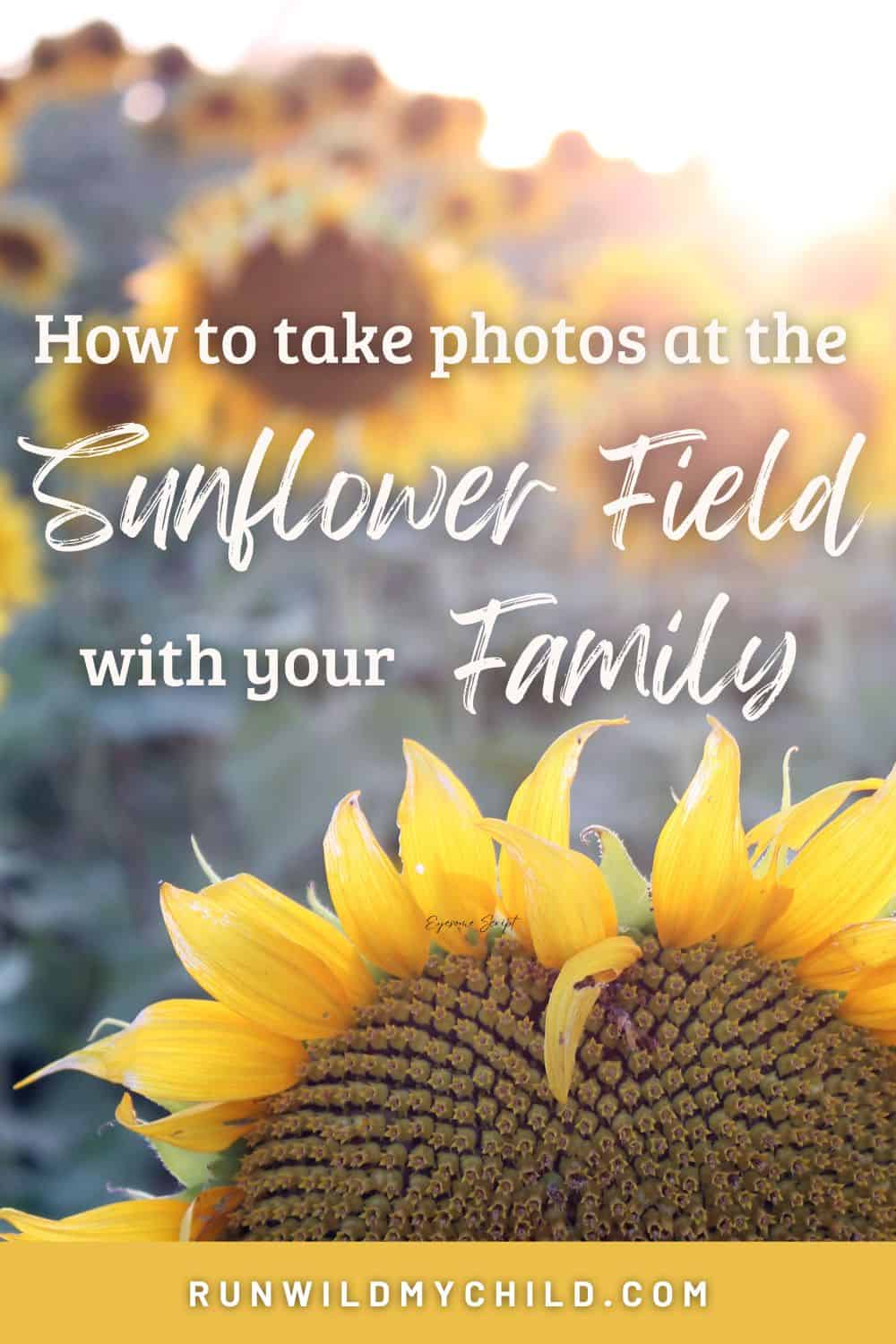
Sunflowers are the flower of summer
The sunflower is the ultimate symbol of summer. Whether growing wild on the side of the road or carefully cultivated in a field, the sunflowers’ vibrant yellow blooms not only delight bees and bring smiles to faces, but they create a gorgeous backdrop for photos. However, sunflower fields are often wild (just like your kids!), so you have to consider the elements when planning a trip to a sunflower field to capture some photos.
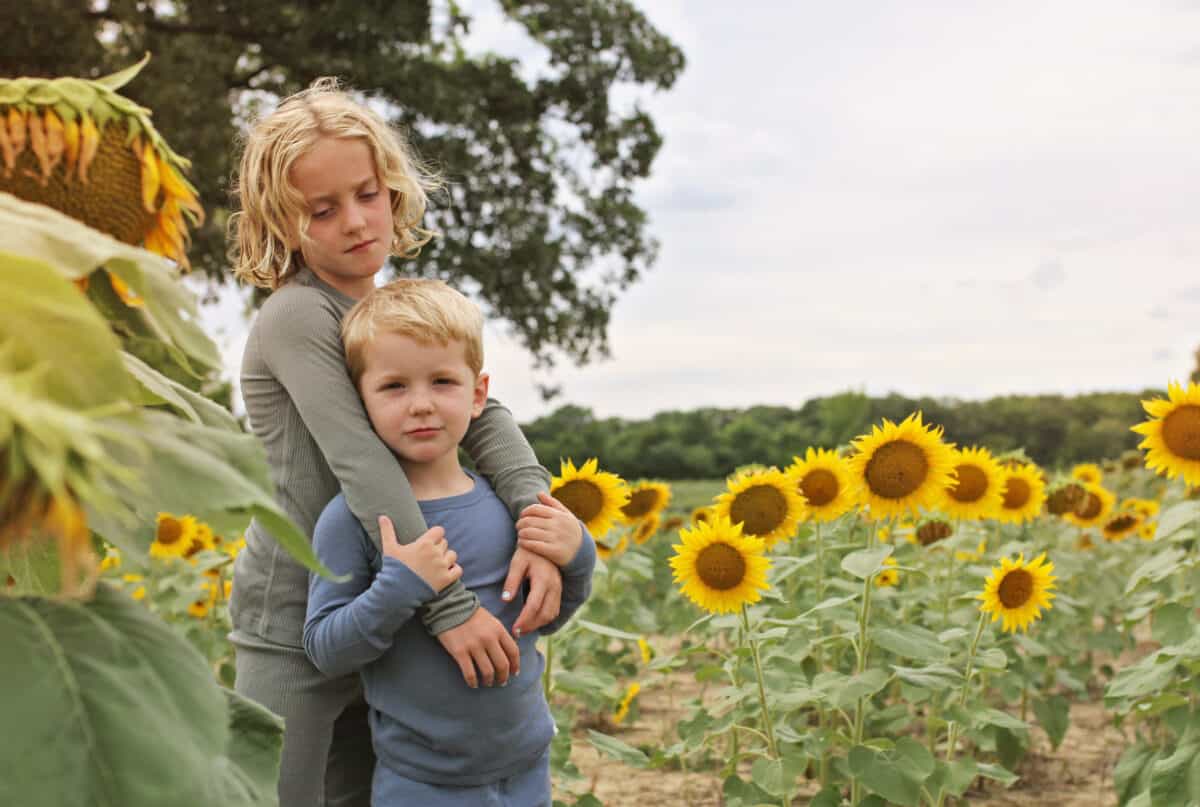
Why take photos in a sunflower field?
Visiting a sunflower field in the summertime for family photos can be a fantastic idea for so many reasons. The vivid colors of the sunflowers can create a visually appealing and cheerful backdrop for your family photos. Sunflower fields offer a natural and picturesque setting that can add a touch of beauty and charm to your family photos. Sunflowers are often associated with positivity, happiness, and warmth. Incorporating these symbols into your family photos can infuse a sense of joy and optimism into the images.
In addition, summer is a time of growth and abundance, and sunflowers are quintessential summer flowers. Capturing your family in a sunflower field can help evoke the essence of the season and create a timeless memory. Sunflower fields can provide a playful and adventurous atmosphere for family photos. Children can enjoy running among the sunflowers, which can lead to candid and spontaneous moments that result in charming photos.
Visiting a sunflower field with your family can be a memorable and enjoyable outing in itself. The experience of being surrounded by nature’s beauty and spending quality time together can be cherished by both parents and children. Sunflower fields can serve as a natural playground for them, making it easier to capture genuine smiles and expressions in the photos. Being in a sunflower field can help your family feel more connected to nature and the environment. This connection can be reflected in the photos, adding depth and authenticity to the images.
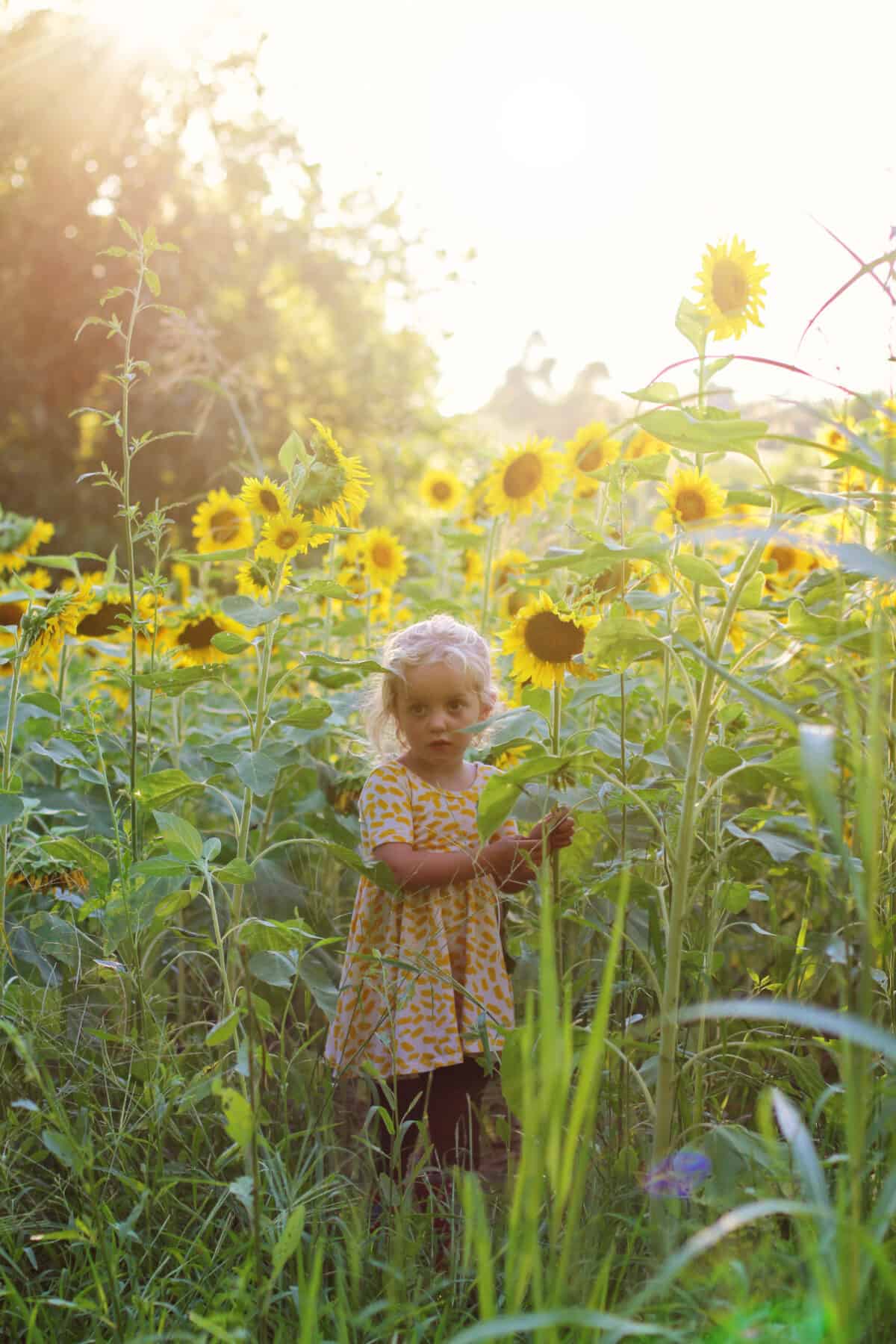
How to plan the perfect sunflower field photo session for your family
Taking quality photos at the sunflower field with your family requires planning and patience. It also takes a little research into the weather, temperature, wildlife, and lighting at the time you’re planning your outing. For nine summers straight, I have loaded up my family to explore sunflower fields – both commercial and wild – in four states (Illinois, Iowa, Kansas, and Missouri). After countless sunflower field adventures and escapades, I feel I have made enough mistakes to help you make your family’s visit to the sunflower field go smoothly!
A little planning goes a long way to ensure your trip to the sunflower field with your family leaves you with gorgeous pictures and fond memories. Here’s everything you need to know to take amazing photos of your family at the sunflower fields this year.

How to find a sunflower field near you
Finding local sunflower fields when they’re in bloom can be difficult if you don’t know where to look. Oftentimes, sunflower fields that you may see when out driving are on private property and, thus, unavailable to use for photos. Here are some effective ways to locate accessible sunflower fields open to the public in your area:
- Online searches: Use search engines like Google to search for “local sunflower fields” or “sunflower fields near me.” This might lead you to websites, blogs, or news articles that provide information about the nearest sunflower fields and their blooming schedules.
- Social media: Platforms like Instagram, Facebook, and Twitter often have local users/influencers/photographers who share their experiences visiting sunflower fields. Use relevant local hashtags to find posts and images from people who have visited sunflower fields in your area. Join local photography groups or forums to see if anyone has shared information about sunflower fields in your area.
- Local event listings: Check out local event listing websites, community forums, or Facebook event pages. Sometimes, sunflower field owners, farms, orchards, parks, or organizations hosting events around sunflower blooms will promote these on such platforms.
- Farm directories: Websites that list local farms and agritourism destinations often provide information about sunflower fields and other seasonal attractions. Examples include LocalHarvest and PickYourOwn.org.
- Local news: Keep an eye on local newspapers, news websites, and TV stations. They often highlight popular seasonal attractions like sunflower fields when they’re in bloom.
- Local tourism websites: Many cities and regions have official tourism websites that showcase local attractions, including seasonal events like sunflower blooms.
- Botanical gardens, nature reserves, conservation areas: Check with your local botanical gardens, nature reserves, conservation areas, or parks, as they sometimes plant sunflower fields for visitors to enjoy.
-
Word of mouth: Ask friends, family members, coworkers, local photographers, or neighbors if they know of any sunflower fields in the area. Personal recommendations can be valuable for finding the best local places from those in the know.
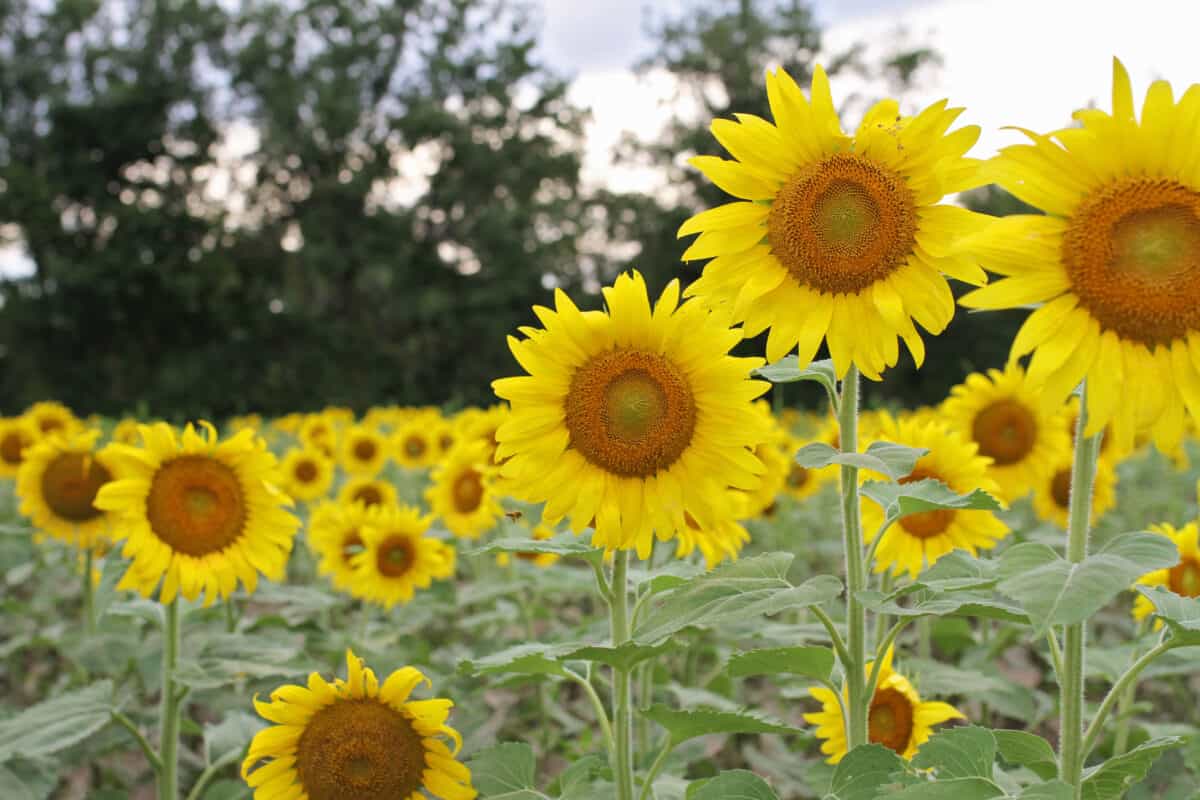
When is peak sunflower bloom season?
Peak sunflower bloom times can vary depending on your location and climate. Generally, sunflowers tend to bloom during the late summer and early fall months. In the Northern part of the US (and Canada), sunflowers tend to peak at the end of July and the first few weeks of August. In the Midwest, August is a great month for sunflowers. And in the Southern US, blooms could go into September.
If you’re not in the US, here’s a rough guideline for peak sunflower bloom season in different regions:
Europe:
- Western Europe: July to September
- Central and Eastern Europe: August to September
Australia:
- Southern Australia: January to March (summer)
- Northern Australia: April to June (dry season)
Asia:
- Depending on the country, the sunflower bloom season can range from July to September.
Keep in mind that these are approximate timeframes and can vary due to factors like local weather conditions, specific sunflower varieties, when the sunflowers were planted, and agricultural practices. It’s a good idea to monitor local sources such as farm websites, social media, and news outlets as the season approaches to get more accurate information about the bloom timing in your area.
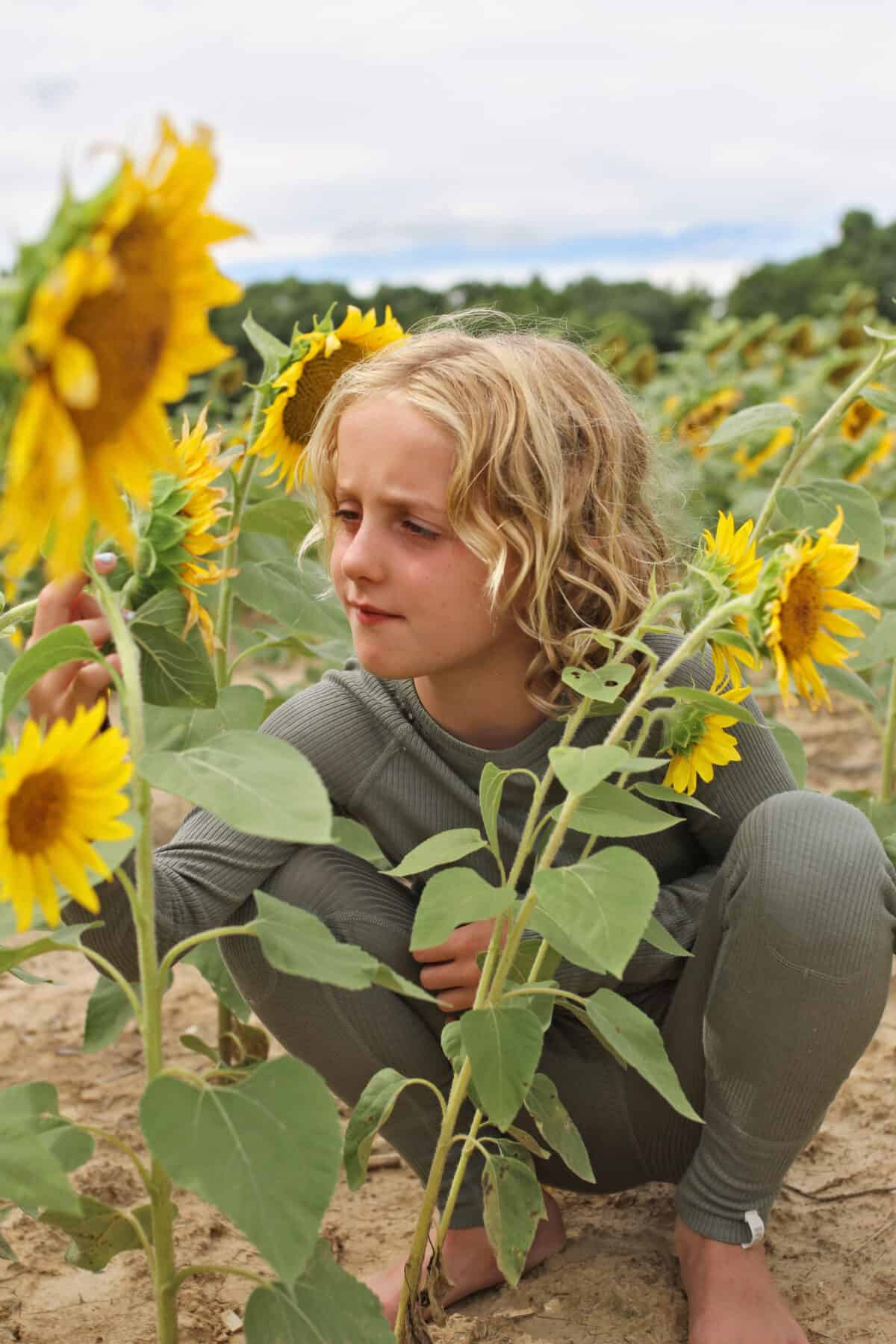
How to prepare for your family’s visit to the sunflower field
Like most adventures with your family, a bit of planning will make things run smoothly. Here are some things to consider and do before heading to the sunflower field with your family to explore the fields and/or take photos.
1. Research the sunflower field’s rules
It’s important to remember that these fields are on someone’s property, and these people rely on this crop for their livelihood.
Most fields have a social media presence, and their rules can be easily found on their Facebook or Instagram. For example, our favorite field here in eastern Kansas posts every year on its Facebook page their “rules of engagement.” Here the owners clearly, and humorously cover everything from bathrooms to behavior expectations when visiting the field.
If a sunflower field does not have its rules listed in one place, here are a few common considerations and etiquette tips for visiting sunflower fields with your family:
- Remember that sunflower fields are often on private property or owned by farmers. Always respect the property and follow any posted rules or guidelines.
- Stick to designated paths and walkways to avoid damaging the sunflowers or trampling on the plants. This helps preserve the beauty of the field for others to enjoy.
- While it might be tempting to pick sunflowers, it’s important not to pick any sunflowers (unless you’re authorized to do so) or damage the plants. Farmers might have plans for the sunflowers after they bloom, such as using them for seeds or other purposes.
- Leave no trace and pack out everything you bring with you, including trash and litter. Keep the field clean and beautiful for others to enjoy.
- Be respectful of the local wildlife, animals and insects that call the field home.
- Be considerate of other visitors by keeping noise levels down, giving people space for photos, and waiting your turn for popular photo spots.
- If you’re taking photos, be aware of other visitors who might also want to capture the beauty of the field. Be patient and allow others to take their shots as well.
- Some sunflower fields might have entry fees, prices for cutting sunflowers, and/or specific visiting hours. Check online or contact the field owner in advance to get information about any requirements. Know what kind of payment they accept.
- Get pertinent information about parking. If you visit an established farm that has other events like pumpkin patches or berry picking, expect to find a designated parking lot. You may have to park on the side of a road for wilder sunflower fields. Either way, find out whether parking is paved, gravel, or dirt (mud!) and plan accordingly.
- Know the bathroom situation. If you’re visiting a farm that hosts other events, they probably have a bathroom of some kind. If you plan to visit a field only open to the public during the sunflower bloom season, then have a “bathroom” plan for your family.
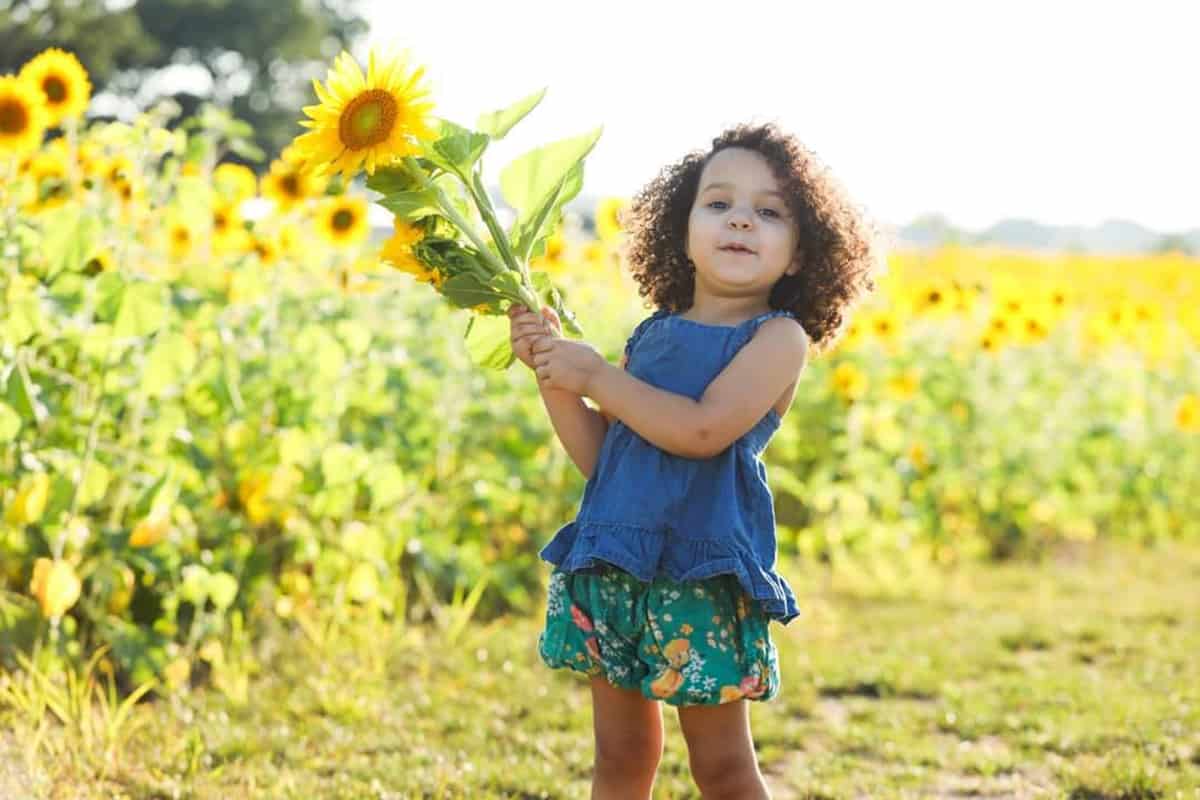
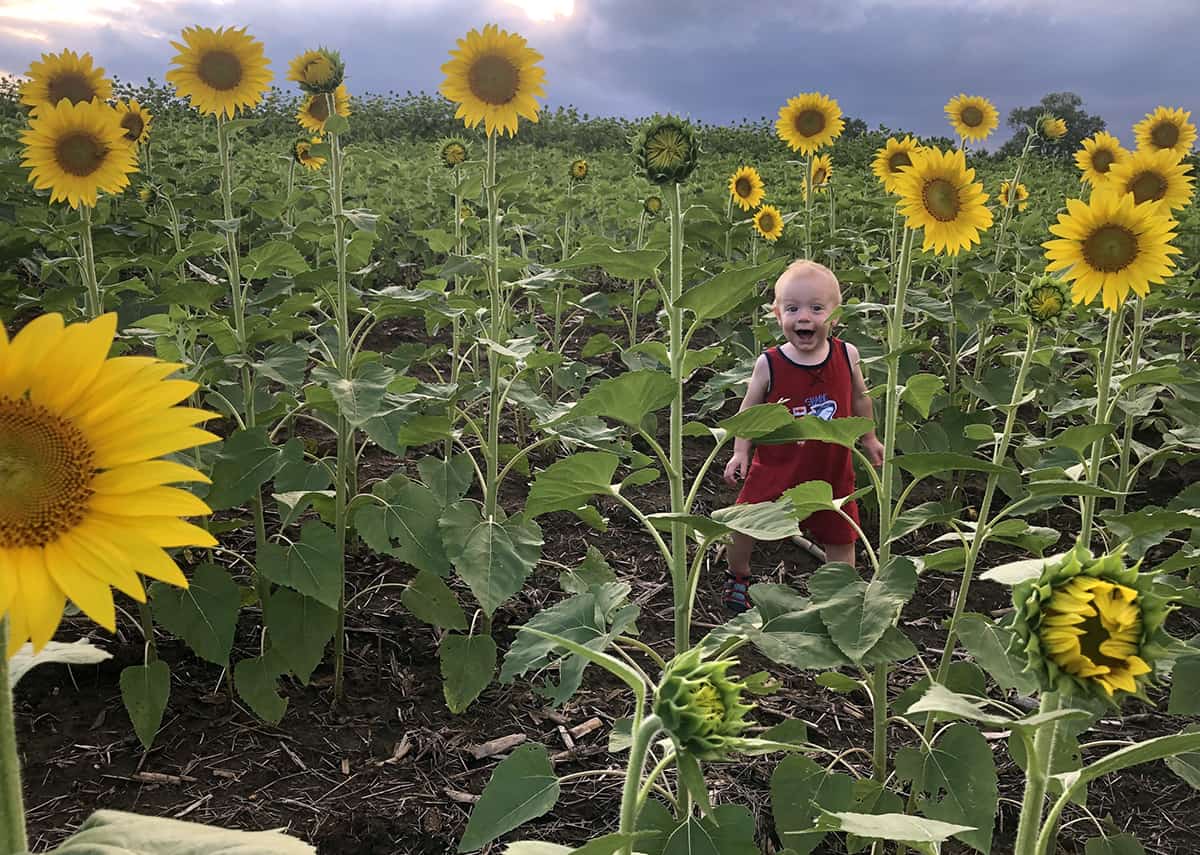
2. Set expectations before visiting the sunflower field with your family
Like any adventure with your kids, it’s important to set clear expectations of their behavior and educate them on what to expect. The sunflowers will most likely stand taller than your children, and if the sunflower field is large, staying together may be difficult. If someone wanders too far, what’s the plan? Is there a place on the edge of the field to head to, like a large rock or a tree?
Before you head out, remind your kids that cut sunflowers don’t survive long. While it’s fun to cut them (if allowed), take only 1-2 and leave the rest in the field for other families to enjoy. Scroll down for fun activities to do with your sunflowers after you cut them.
“Leave No Trace” principles apply to the sunflower field. Keep in mind this is someone’s land, and the sunflowers are their livelihood. The owners will need to run a tractor through the field to harvest all the sunflowers when the time comes. Things that do not help their tractor run include dirty diapers, keys, cell phones, trash, and large items you drug out there but were too lazy to drag back. Leave the field better than you found it. Pick up any trash lying around, and pack out whatever you pack in.
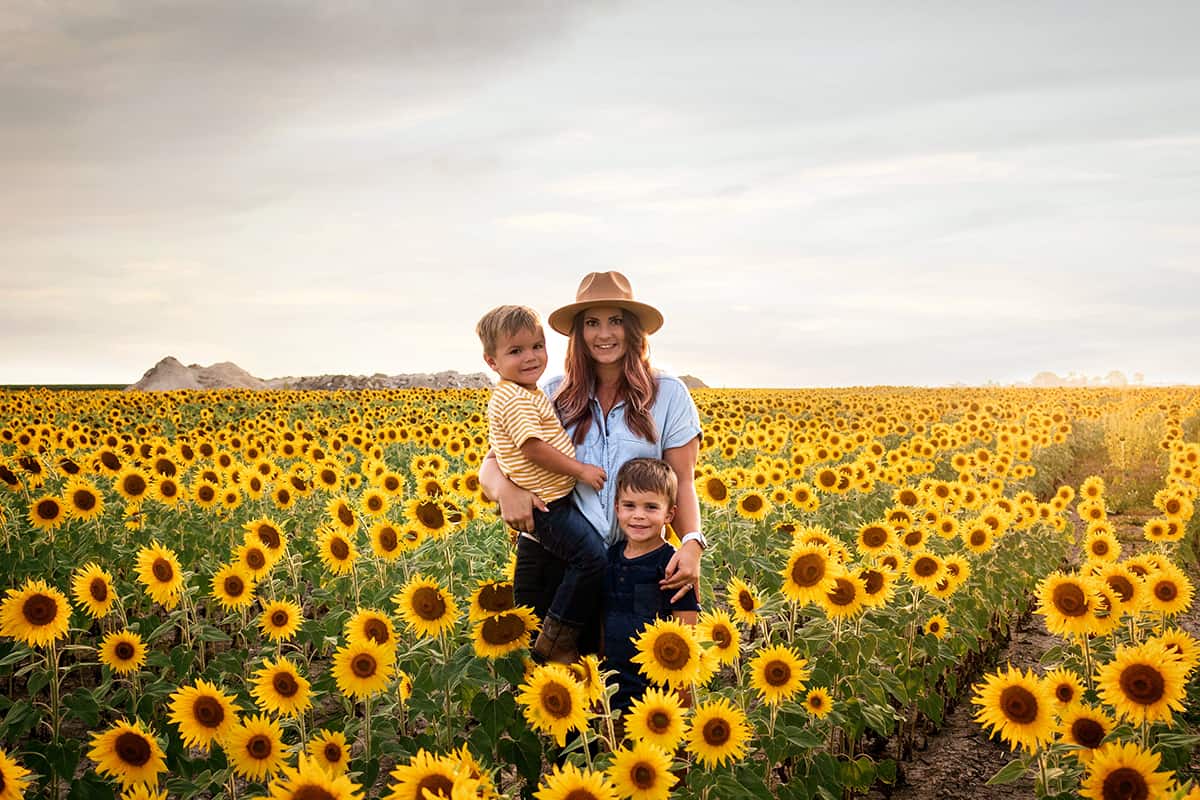
What to wear to the sunflower field with your family
If you plan to include your family in the photos at the sunflower field, put some thought into what everyone wears, just like with any family photo shoot. Take into consideration the weather and dress accordingly. Sunflower season tends to be sunny, hot, and often humid.
While it looks fantastic having your kids dressed up in photos, my family opts for comfort over style. I know it will help my kids enjoy the experience, which means they will cooperate with my (seemingly incessant) photo requests. My kids and husband wear synthetic shirts or polos (usually Under Armor), and I wear a workout top that will not show sweat easily.
Also, take into consideration color choices and choose clothing that will complement the yellows and greens (and not clash with them). Stick with complementary colors like blues, whites, browns, and oranges. I always lean towards blue. We tend to go in the evening so navy and royal blue work well. If we go midday I choose a lighter blue. As far as color scheme, you want your family to stand out amongst the flowers, but not completely steal the show. Also, try to avoid wearing clothing with logos, sayings, patterns, and characters. Stick with neutral solids in complementary colors.
Whatever your family wears, make sure that you don’t mind them getting dirty, your kids feel comfortable wearing them, and they can move easily.
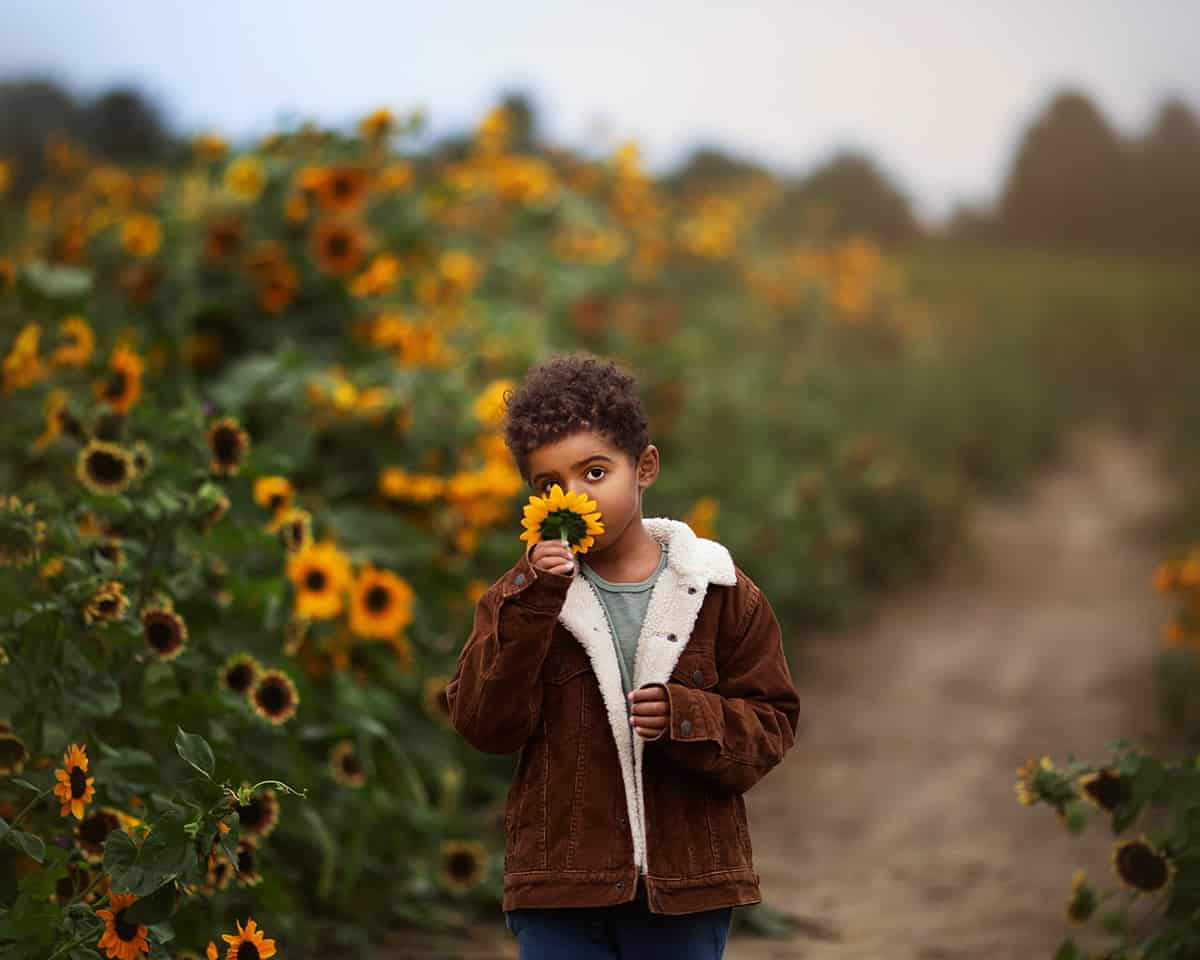
Packing list for family photos in the sunflower field
The weather, time of day, and the size of the field, and the accommodations available will affect your packing list. Water and snacks are mandatory for every family adventure. Here is our list of things to bring to ensure your trip to the sunflower field with your family goes smoothly.
Bug repellant
There will be bugs. Prep your kids for an abundance of pollinators zooming around the sunflower blooms. Also, because it’s a field, expect mosquitos, ticks, chiggers, and other bitey insects. We always shower and do a thorough tick check when returning home from the field.
Sun protection
Whatever you use, bring them (sunglasses, hats, sunscreen, protective clothing). You can always remove hats and sunglasses for photos. Consider a non-toxic reef-safe sunscreen if you’re going to be touching plants and/or wildlife.
Change of clothes/shoes
From toileting accidents to unexpected mud, pack a bag with extra clothes and shoes to ensure comfort on the ride home. Feel free to leave your change of clothes in the car; no need to lug it out to the sunflower field with you.
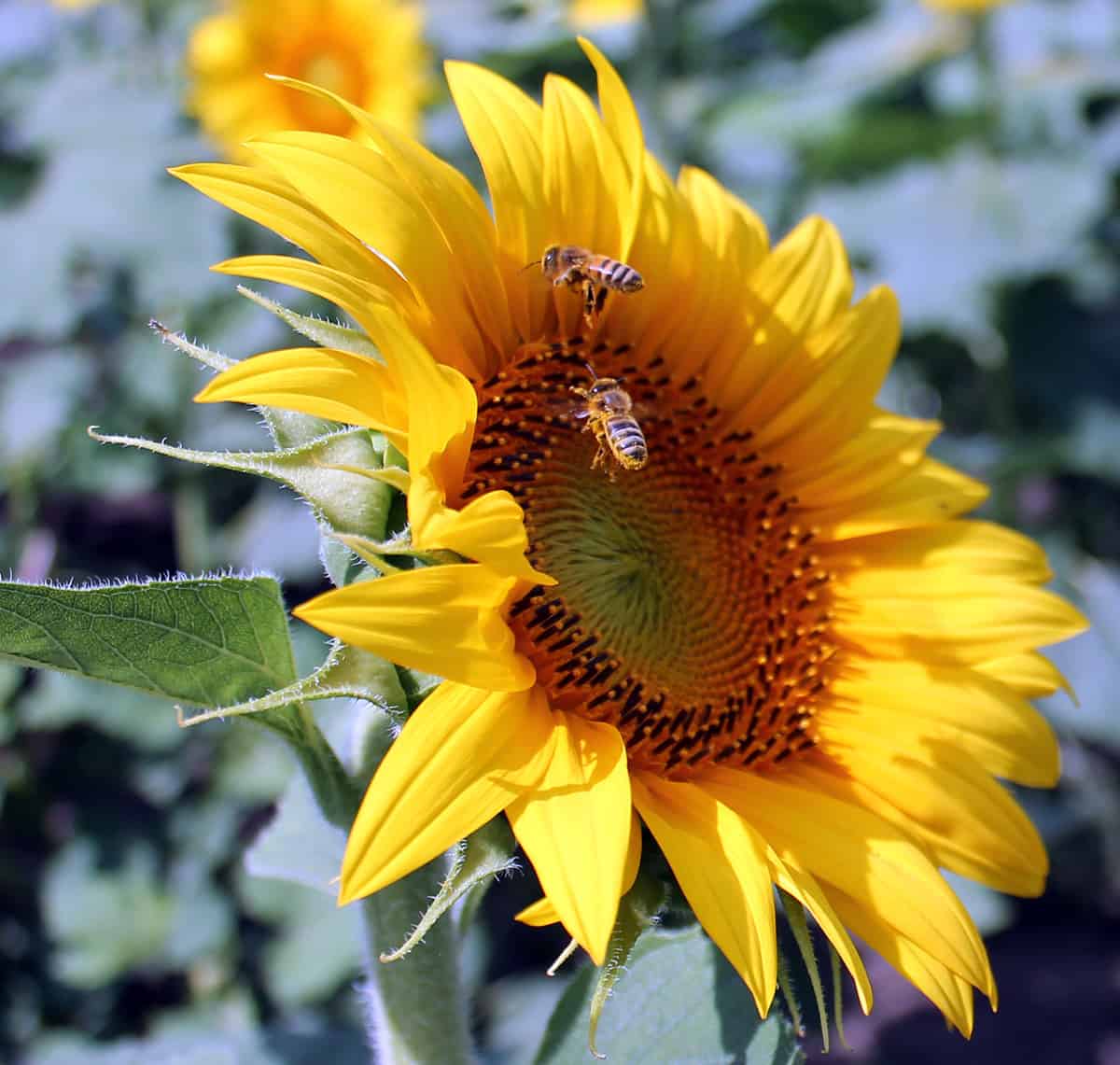
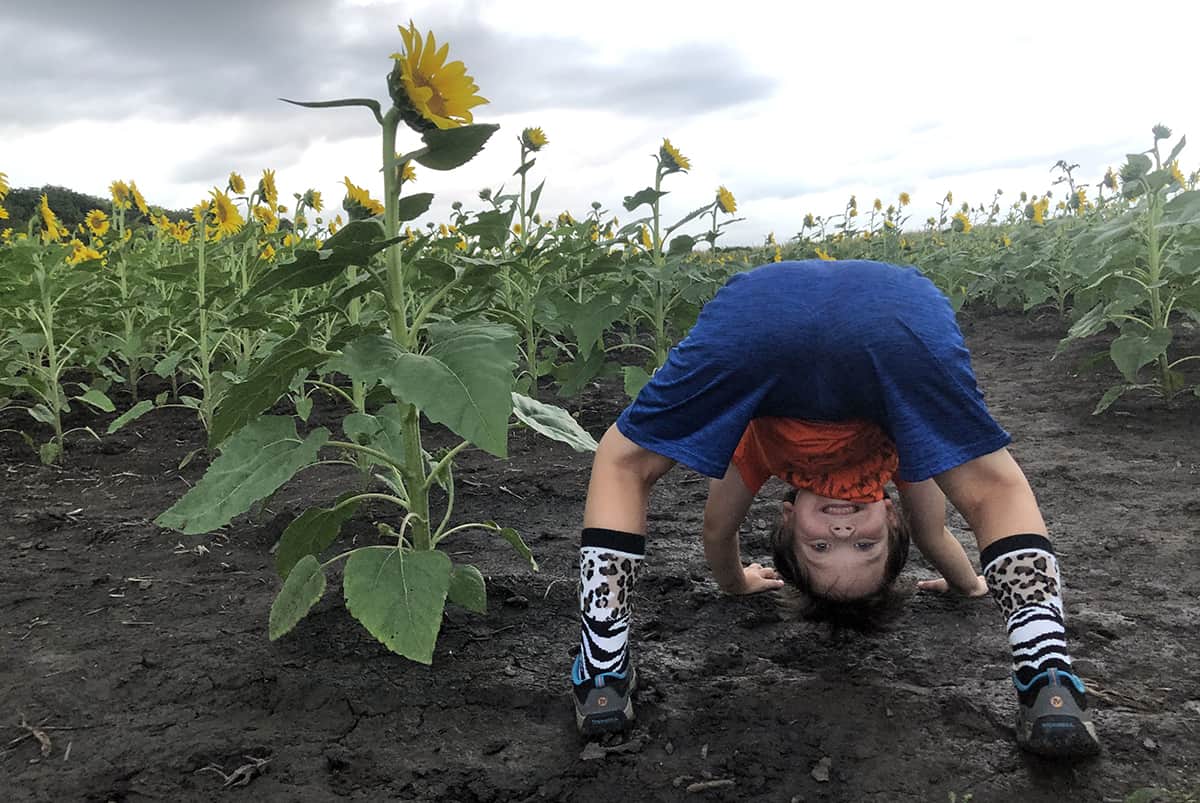
Toileting supplies
Do bring these out into the field with us. My backpack includes wet wipes, tissues, a diaper or two, a Kula cloth, and plastic bags. Remember to follow Leave No Trace principles – pack everything out.
Camera
Whatever camera you’ll be using, make sure to bring it along. While we love a beautiful DSLR image, you can get some pretty spectacular photos using just your smartphone. If you need photography tips and tutorials, be sure to check out these tips for how to take better photos of your outdoor adventures using your iPhone.
Tripod
Optional, but odds are, you want to be in the photos with your family. A tripod, along with a timer or remote, will allow you to set up your photos and appear in them. I recommend bringing a tripod with adjustable leg heights.
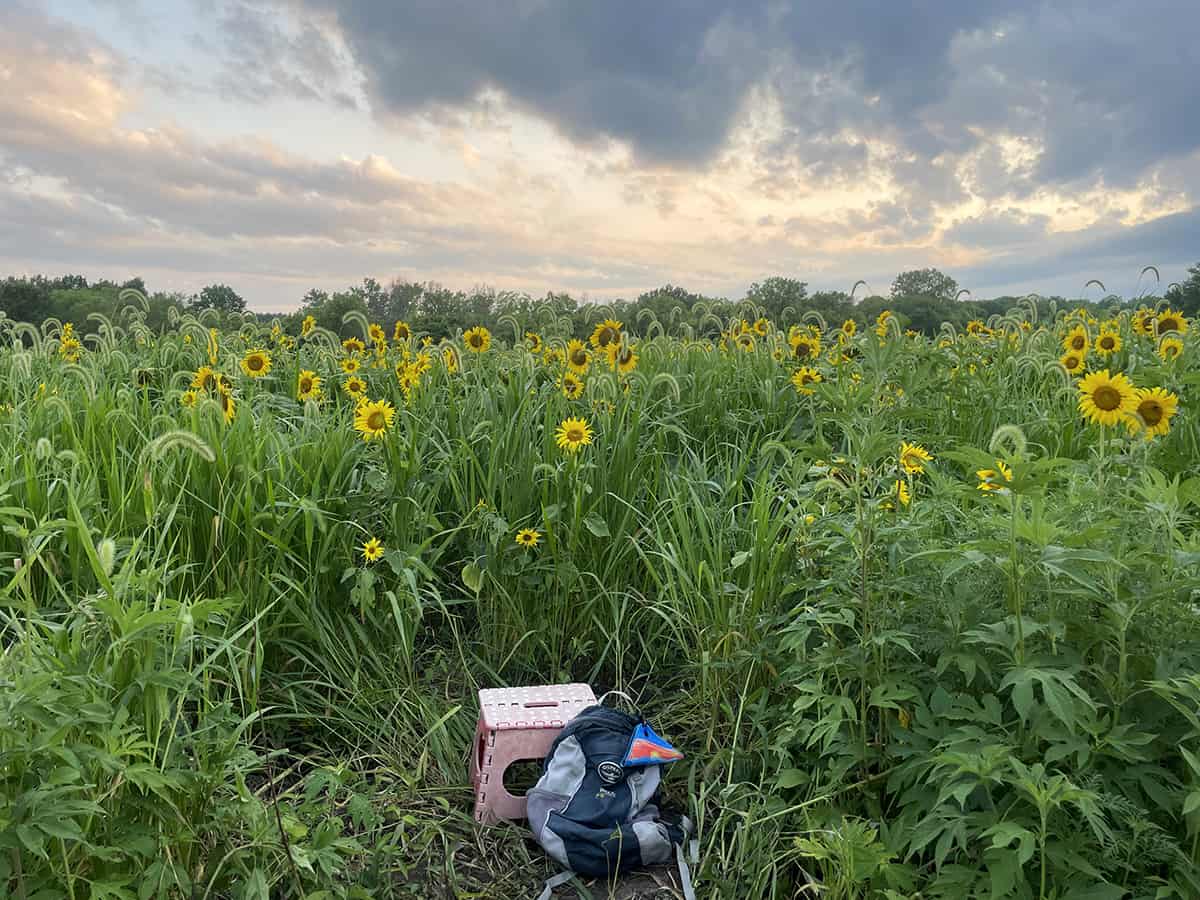
Stool
Changing your angle makes a big difference when photographing sunflower fields. Having the ability to stand on an elevated surface can help hide double chins and allow you to show how vast the field is by being able to see over the tops of the flowers. A gardening stool or even a Squatty Potty will work. I attach my collapsible stool to my backpack with a carabiner to make carrying it easier.
Props for photos
People bring all sorts of things to pose with in the sunflower fields: decorative chairs, bicycles, baskets, umbrellas, and even bubbles. You may want to load everything up into a wagon, like one you would use to haul things to your kids’ sporting events. Or you could use a wagon to haul things, and as a prop in the images, so something like an old metal Radio Flyer wagon would look great.
Let your kids pick out something fun to bring as well. Mine love to bring binoculars, a favorite hat, stuffed animals, magnifying glasses, and an old point-and-shoot digital camera so they can take photos as well.
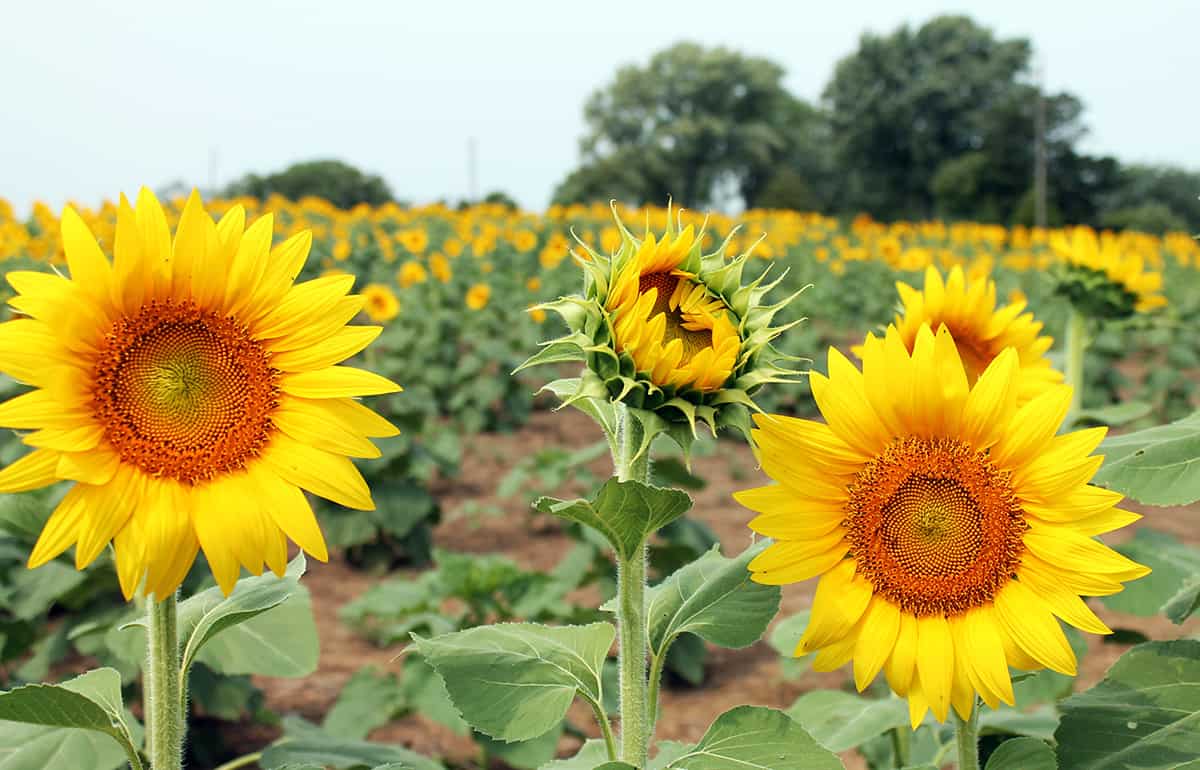
Tips for photographing sunflowers with your family
Fun fact to share with your kids about sunflowers: they are heliotropic. Sunflower heads follow the sun as they grow until they fully bloom. As they grow, they face east in the mornings to greet the rising sun and slowly follow the sun across the sky as the day progresses. Overnight, they return to facing east ready for the sunrise.
1. Know the best time to take sunflower photos with your family
Understanding heliotropism comes in handy when planning a visit to the sunflower field with your family. If you’re familiar with the sunflower fields, consider what will be in the background in that direction at the time you’re visiting. If you visit the field in full bloom, expect the majority of the blooms to face east.
Try to avoid visiting the sunflower field with your family during midday if you can. It’s hotter during this time, and most sunflower fields don’t have shade. The sun sits overhead, resulting in blown-out backgrounds, sun streaks, and harsh shadows (like the photo below). Harsh is usually not an adjective we want to describe our family photos.
Aim to visit the sunflower field with your family in the early morning or the golden hour (1-2 hours before sunset). If you go in the early morning, the sunrise will illuminate the front of the sunflower blooms and your subjects (if you pose them in front of the flowers). If you can’t make it at these times, try visiting on a cloudy day. Cloud coverage will keep the harsh shadows at bay.
If you visit during the golden hour, the sunset will backlight the blooms, which will create a glowing effect around them, as well as help you capture the vivid colors of the sky as the sun sets. As nightfall approaches, you may need help to illuminate the sunflower blooms and your subjects.
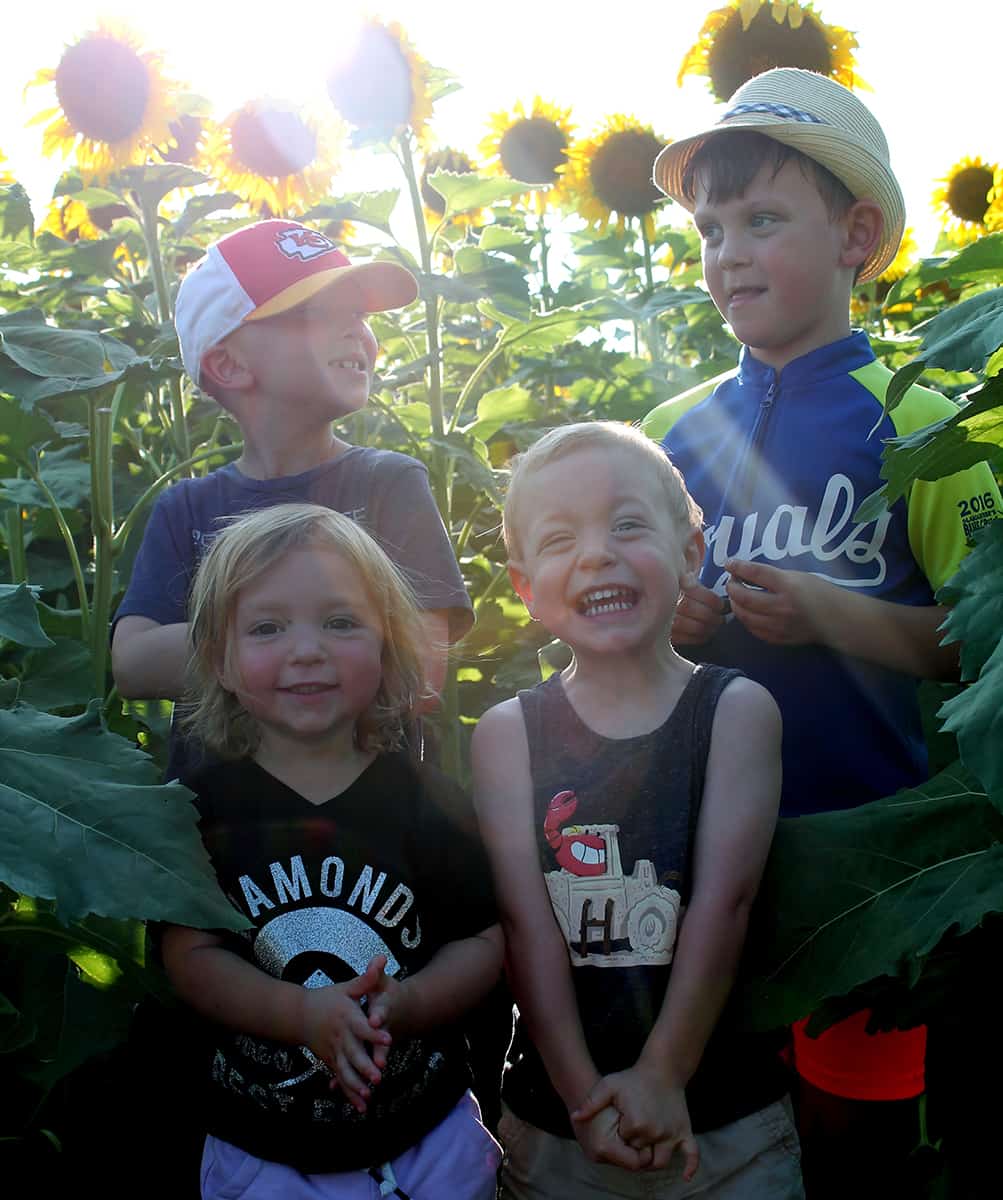

2. Get creative with different angles when photographing at the sunflower field
For me, it’s tempting to take all close-up shots of sunflowers (and my family) because I love the different textures and patterns of the flower and stem. However, variety is the spice of life and getting creative in the different angles and perspectives you can use in your photos will give them each a unique look and feel. Besides close-ups, here are some different ways to photograph sunflowers and your family in the field.
Pull back
If you’re at a larger field, try to capture the endlessness of the blooms by widening your shot. Use hills to your advantage for this, if your field has them. Experiment with standing at the base of the hill, photographing up, and standing atop the hill shooting down.
Experiment with aperture
Widen your depth of field (using a lower/small aperture) if using a DSLR to blur the flowers in the background. You can also do this on your smartphone using portrait mode. Crop trees out as you frame your shot, as they interrupt that endless feeling unless the field is ginormous and trees mark the boundary of the field.
Play with the light
You can also get creative when utilizing the sunlight in your images. In the evening hours, experiment with the sun shining through the sunflower blooms. Adjust how you frame the image to have the sunburst peak between flowers or have a bloom block it to create a glowing effect.
Change your perspective
Here’s where the stool and change of clothes will come in handy. Use a foldable gardening stool or Squatty Potty to get more sunflowers in your frame by elevating yourself. This works especially well for fields with taller sunflowers. Elevating your camera will also reduce the appearance of double chins.
Or, try getting really low and shoot up into the sunflowers. Crouch or even sit down and aim your camera up at the blooms. Experiment with this to see if you find a perspective you like. Finally, remember that the backs of sunflowers look beautiful as well. Don’t forget to shoot different sides of the sunflowers.
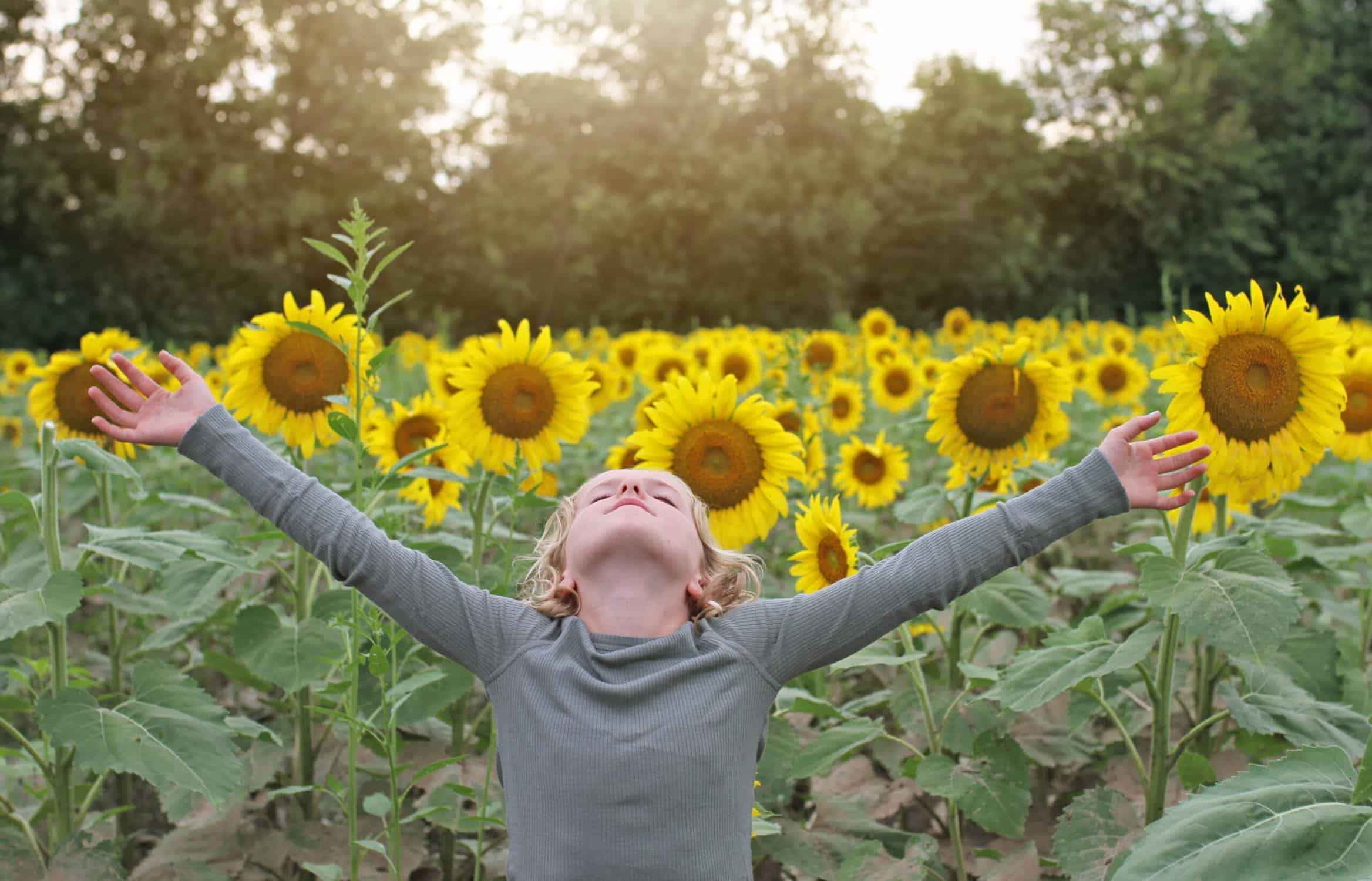
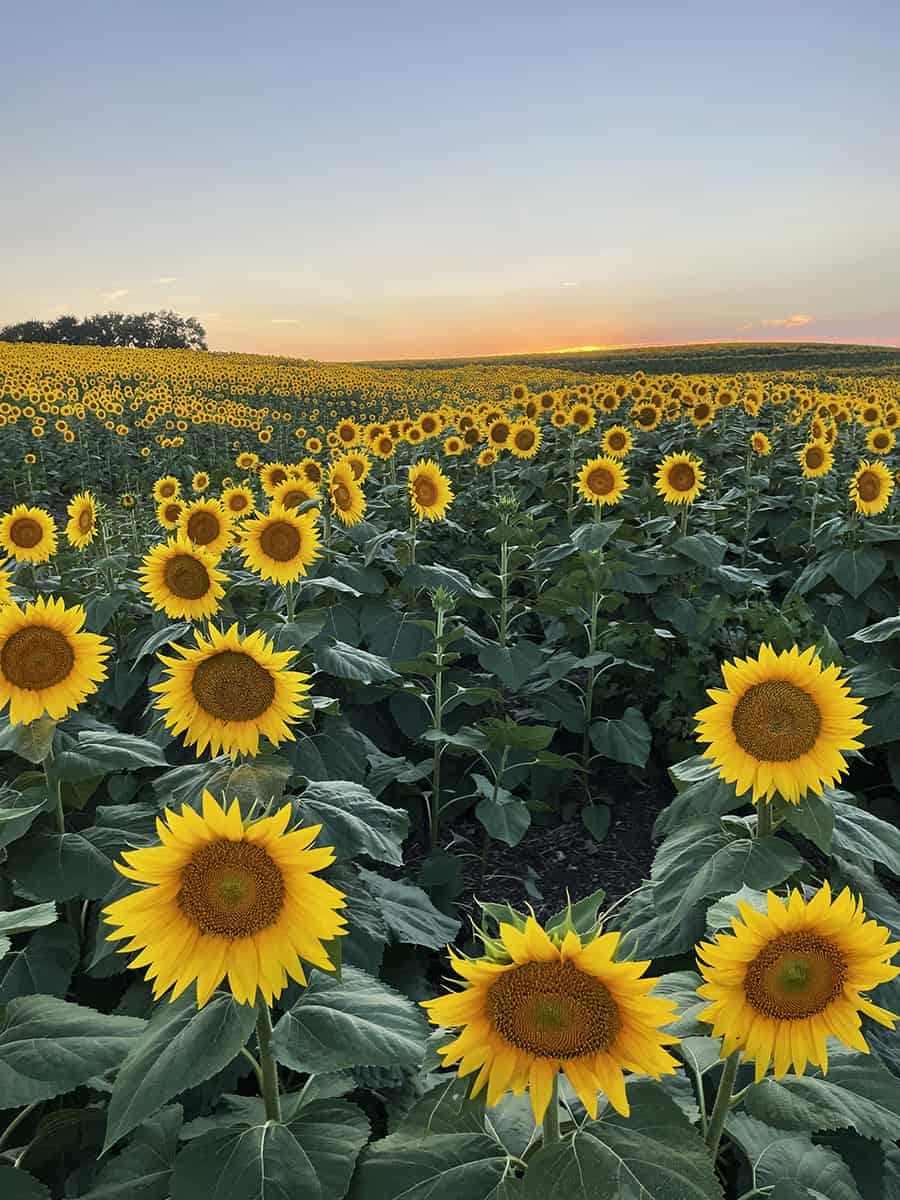
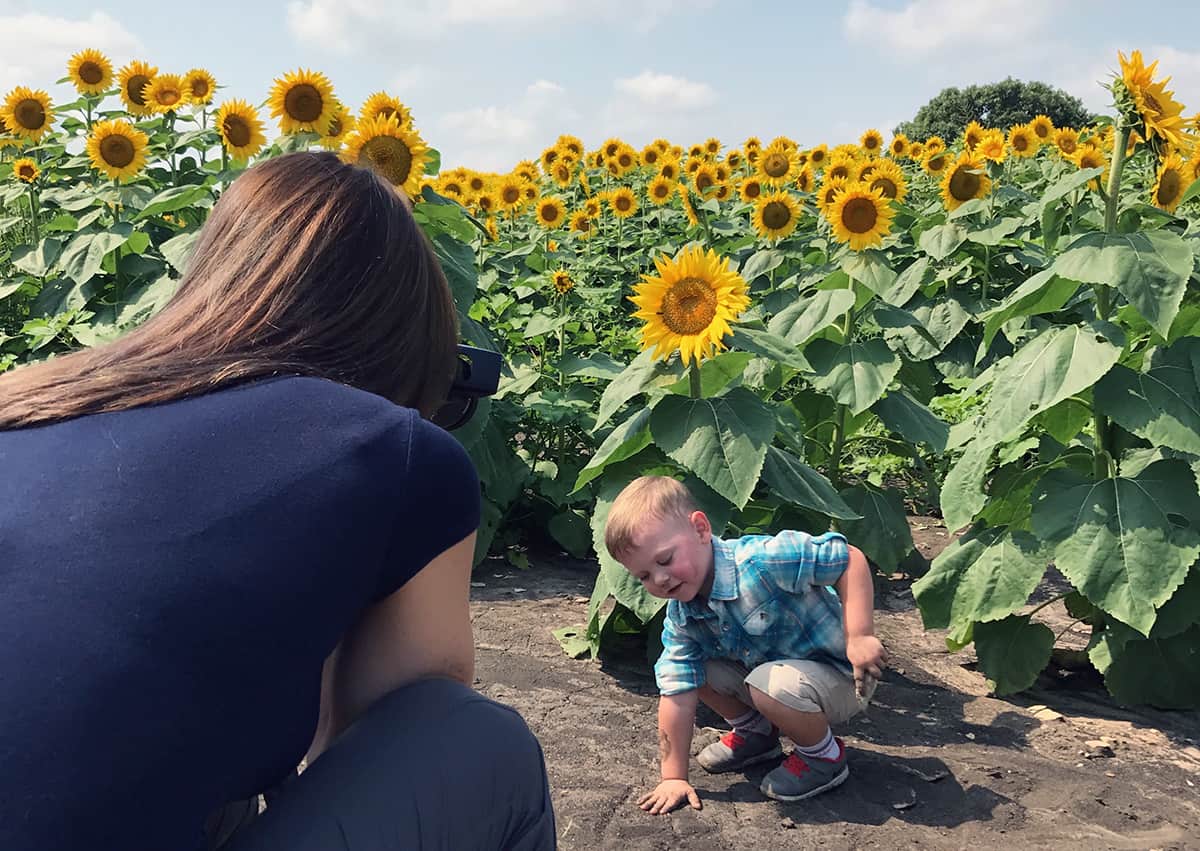
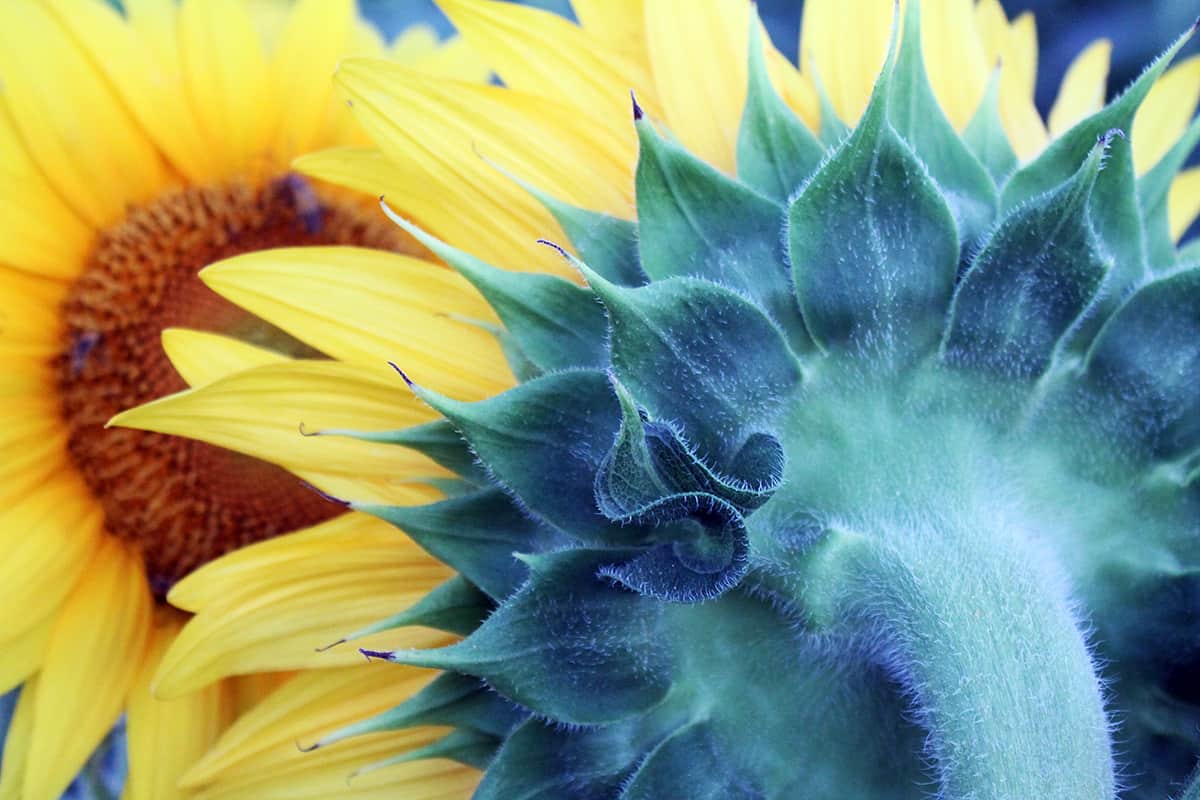

Things to do after you visit the sunflower field
The fun doesn’t have to end once your family leaves the sunflower field. Here are three crafty projects you can easily complete with your kids in the days following your visit to the sunflowers to keep the excitement alive.
Sunflower portraits
There are lots of options with making your own sunflower portraits, with no right or wrong way to do this fun sunflower activity, as long as everyone has fun.
Take photos of the sunflowers you cut from the field and stage them in a vase on your table or the ground (inside or outside). Poll your kids to see what mediums they want to use to create their sunflower portrait. Chalk on dark-colored construction paper is always a hit at our house. Or, have your kids use a permanent marker to outline the shape of the flower, and watercolor paints to color in their sunflower.
Don’t stress too much about supplies for this craft. Even a box of regular crayons or markers paired with scratch paper from around the house produces memorable work.
Once they finish, you can frame and display your kids’ creations alongside the photos you took in the sunflower field to create a unique and memorable gallery wall. Or stick them on the fridge.
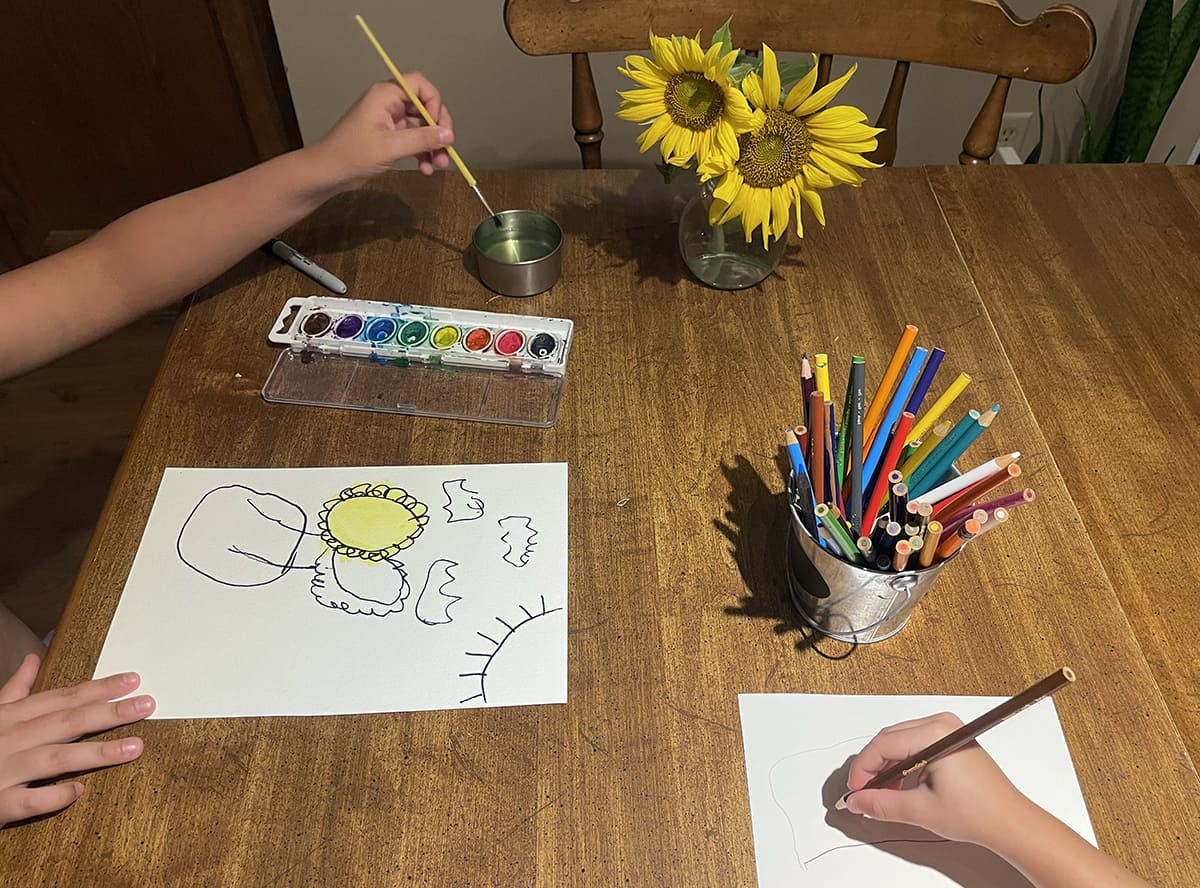
Continue the sunflower photo shoot at home
Back at home, hand over your camera (or phone) to your kids and allow them to orchestrate their sunflower photoshoot with the stem(s) you cut from the field. Use a cardboard box to create a homemade studio. Allow your kids to find things around the house or yard to use as props and backgrounds. Teach them to play with lighting. Taking photos near a window will create different shadows and colors than if they use a flashlight or lamp as a light source. The possibilities are endless.
You can also continue the photoshoot at home. Remove the sunflowers from their natural environment and photograph your family with the cut blooms out of the field for a unique twist.
Don’t feel like you need to do this photoshoot as soon as you return home from the sunflower field. You can wait until the sunflowers dry out. Hang them upside down in a dry location for 4-5 days, before taking photos. Try converting their digital images to black and white. The textures on dried sunflowers look even more impressive in high contrast.
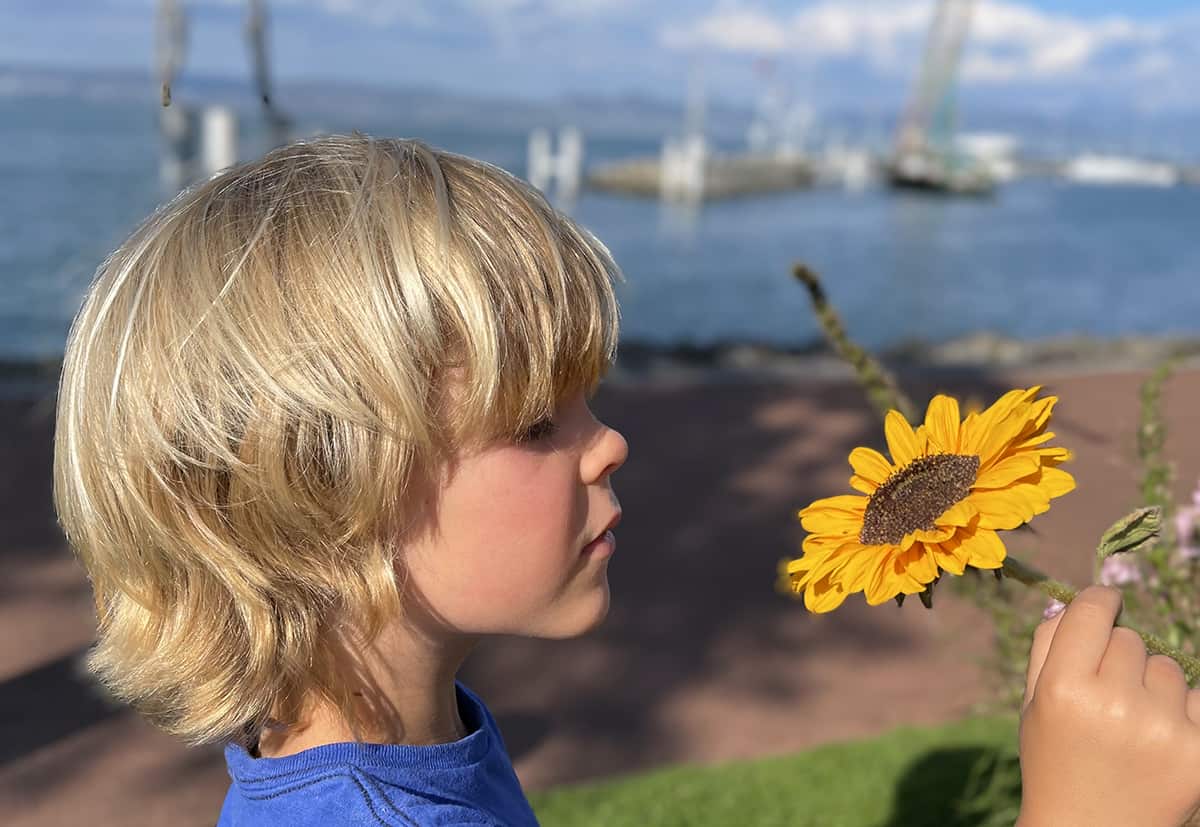
Harvest your sunflower seeds
Cut sunflowers only last so long before they begin to droop due to the weight of the bloom. You can harvest the seeds to plant in next year’s garden, bake them for a tasty snack, or use them as bird feed. Pair a bag of seeds with a sunflower portrait or photo your child took for the perfect gift for friends, family, or teachers.
To harvest your sunflower seeds, find a dry place to hang the blooms upside down. The flower petals will wilt and begin to fall off, and the backside of the sunflower will brown. Continue to dry the sunflower until the seeds begin to loosen from the head. When the sunflower is completely dry, brush the seeds with your hand to remove them. Use tweezers to remove stubborn seeds.
Rinse the sunflower seeds and thoroughly dry them. Store seeds in a cool, dry place until you’re ready to use them. We have a spot in our pantry where we store our seeds, up high and out of the way (but brightly labeled so I don’t forget about them).
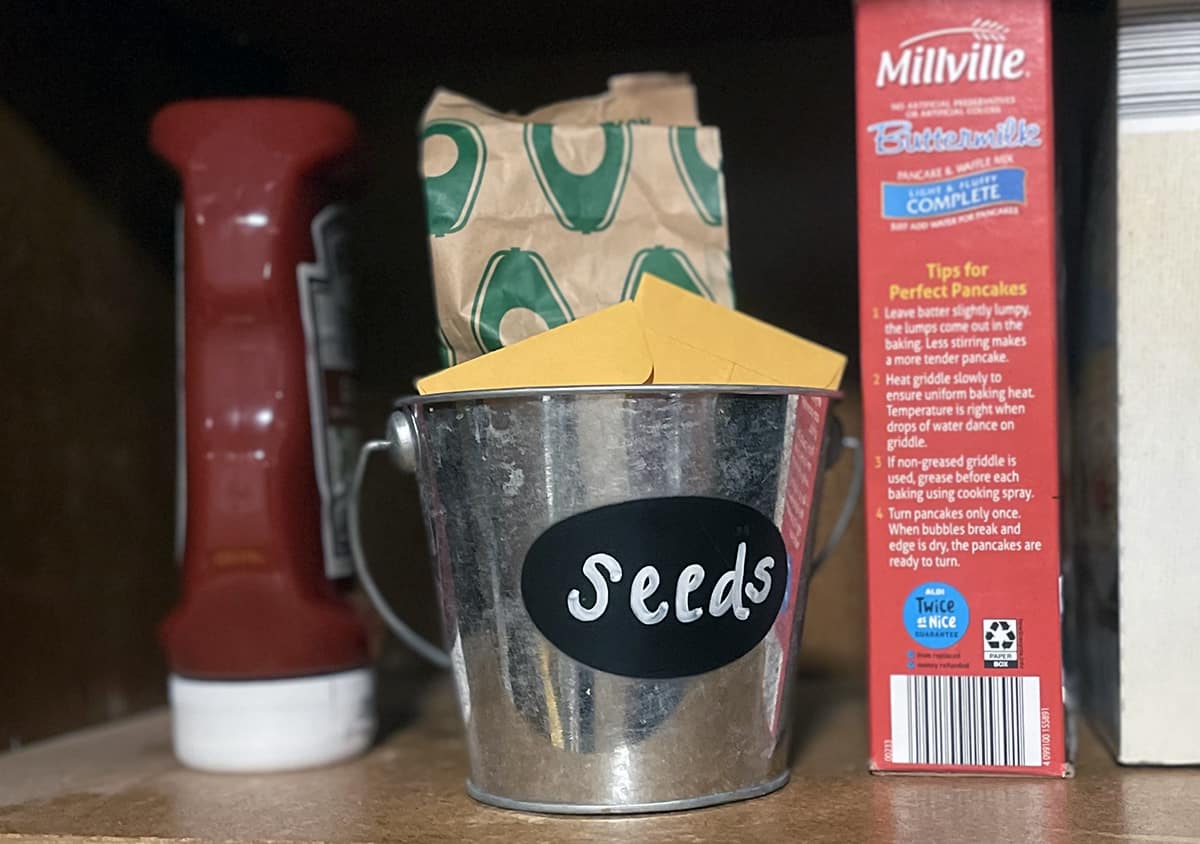
The importance of family photos
Capturing your family’s memories through photos is one of the best ways to tell your story. No, not just for Instagram, but for your family’s posterity and future. While social media might make it seem as if photo taking and storytelling are trendy here and now, photos are forever. Each one is a frozen moment in time you can go back to again and again. I am in it for the long-term payout.
Not only are photos a wonderful way for parents to remember the big and small moments and details, but they’re a way to pass down those memories to your children and grandchildren. I want our memories, stories, and adventures to be stamped into the soul of our family. I want them to bring us joy for years and serve as the roots that keep us all grounded and connected.
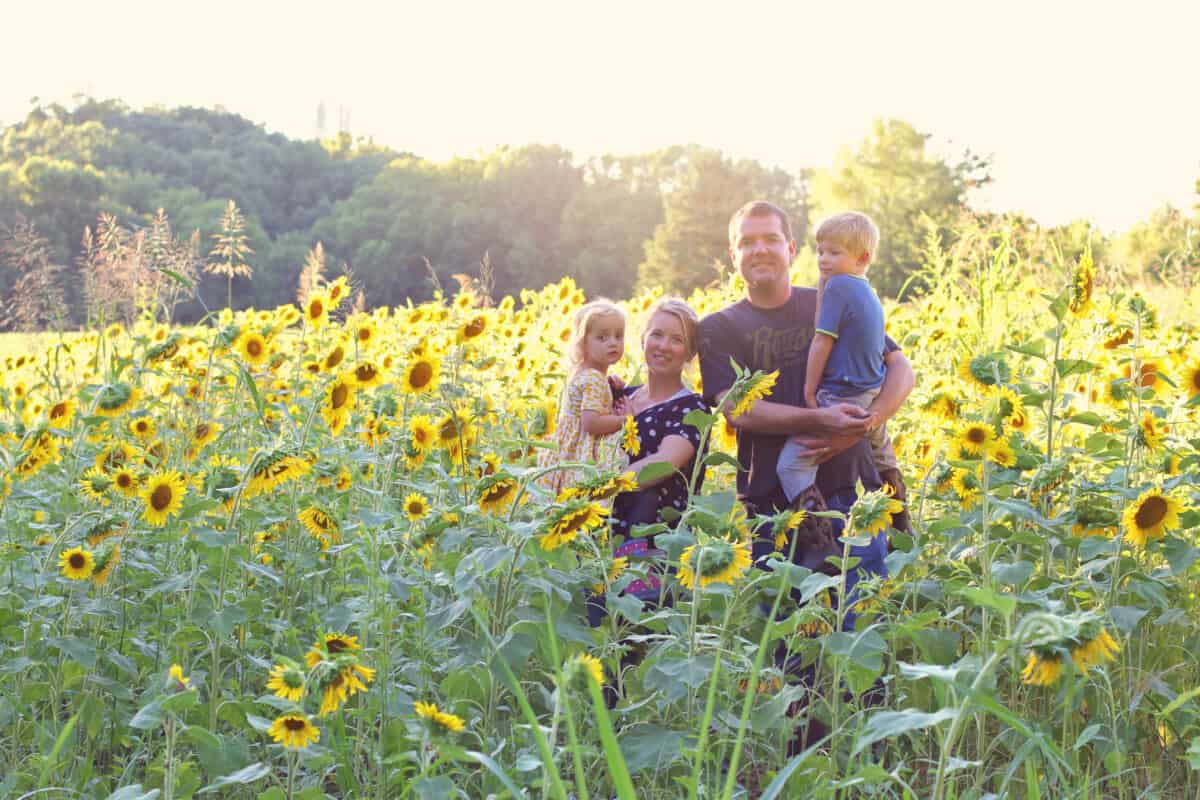
Sunflower family photos
In the radiant embrace of a sunflower field during the summer, an opportunity for captivating gorgeous family photos comes to life. With their vibrant petals stretching toward the sun, the sunflower’s cheerful blooms set the stage for a backdrop that resonates with positivity, happiness, and the very essence of the season. Amidst the sea of golden hues, children’s laughter blends with the rustling of leaves, creating a playful and heartwarming atmosphere that encapsulates the joy of familial bonds.
Over the years, these images become more than just photographs; they are portals to cherished memories of a day spent amidst nature’s beauty and the warmth of your loved ones. In capturing the love, laughter, and togetherness within the sunflower field’s embrace, you immortalize not only the moment but also the unique spirit of summer and the irreplaceable moments shared by your family. I hope this post will inspire you to get out into a sunflower field soon and capture some memories!
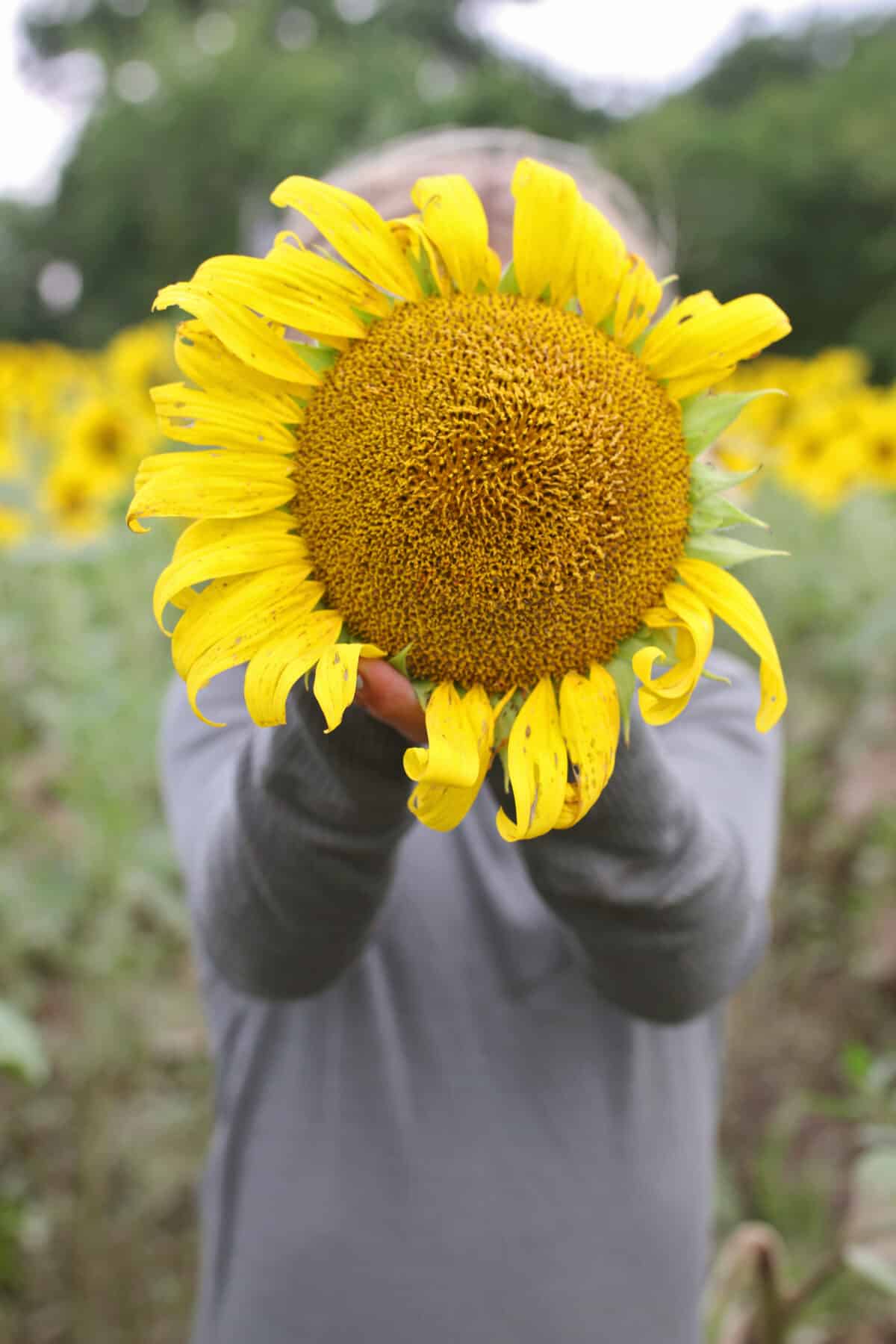
Have you ever visited a sunflower field for photos?
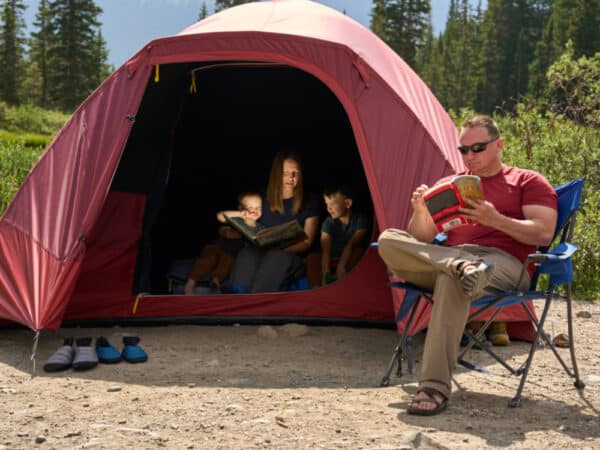
About the author
Writer, editor, photographer, teacher, and mama. Sarah Boles resides near Kansas City, Missouri, and escapes into the woods whenever she can. Her professional and personal mission is to help families get outside by increasing access to the outdoors for everyone. When she’s not creating or teaching, Sarah’s playing outside, usually with her kids. She loves to climb, hike, run trails, snowshoe, paddle, jump in puddles, garden, and pick up trash.
You can find more from Sarah online in the following locations:
Instagram: @on_belay_edits
RWMC posts: Sarah Boles
Comments
One response to “How to Take Photos at a Sunflower Field with Your Family”
[…] © RUN WILD MY CHILD • […]


Leave a Reply